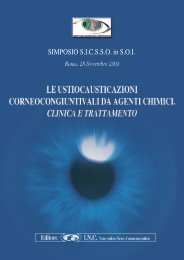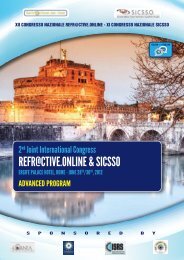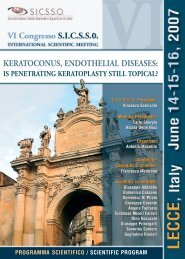1st EuCornea Congress
1st EuCornea Congress
1st EuCornea Congress
You also want an ePaper? Increase the reach of your titles
YUMPU automatically turns print PDFs into web optimized ePapers that Google loves.
<strong>1st</strong> <strong>EuCornea</strong> <strong>Congress</strong> venice, 17-19 june 2010<br />
INVITED SPEAKERS<br />
Midena, Edoardo<br />
Corneal biomechanics in the keratoconic cornea<br />
E. Midena<br />
Padua, Italy<br />
Keratoconus is a corneal disease of unknown etiology. This disorder<br />
is characterized by initially subtle changes of corneal morphology and<br />
biomechanics, when pure surface techniques are still normal. Corneal<br />
layers/cells morphology, corneal hysteresis and corneal resistance<br />
factor are new approaches to the problem of corneal biomechanics in<br />
keratoconus. Quantitative differences in morphology and mechanical<br />
behaviour on corneal keratocytes have been found by differential<br />
interference contrast microscopy. Moreover, three-dimensional finite<br />
element simulations to analyze the biomechanical factors contributing<br />
to the distorted shape of a keratoconic cornea have been performed.<br />
These analyses revealed that three factors affect the shape of keratoconic<br />
corneas: localized thinning, and reduction in the tissue’s meridian elastic<br />
modulus or reduction in the shear modulus perpendicular to the corneal<br />
surface. Thinning showed the most predominant effect. Maximal stress<br />
levels occurred at the centers of the bulged regions, at the thinnest points.<br />
Present and future biomechanical studies will allow a better characterization<br />
of the intrinsic interactions in early and more advanced keratoconus, with<br />
the aim of a very early diagnosis and more accurate monitoring of this<br />
disorder.<br />
Nubile, Mario<br />
In vivo microscopic diagnosis of limbal stem cell<br />
deficiency and related conditions<br />
M. Nubile<br />
Ophthalmic Clinic, University ‘G. D’Annunzio’ of Chieti and Pescara Italy<br />
Corneal conjunctivalization il LSCD has been investigated by means of<br />
IVCM and pathologic tissue was composed of hyperreflective epithelial<br />
cells with bright nuclei and hyperreflective round hyperreflective cells<br />
interpretable as goblet cells 22. Aim of this study is to compare LSIVCM<br />
and IC results in the analysis of central corneal epithelium and detection of<br />
corneal conjunctivalization in patients with suspected LSCD and to correlate<br />
partial or total LSCD with alterations of limbal anatomy evaluated by means<br />
of LSIVCM. Data reported in this study confirm the utility of IVCM in ocular<br />
surface investigation. This diagnostic device infact is able to investigate in<br />
vivo and in a non invasive way obtaining results similar to that obtained with<br />
IC which is an ex vivo analysis that need specialized operators and specific<br />
laboratory structures to be performed. Correlations resulted between<br />
presence of total or partial corneal conjunctivalization and morphological<br />
alterations of LSCD open new prospective for study and understanding<br />
physiopathology of epithelial cells renewing in ocular surface.<br />
Pels, ELiSabeth<br />
Organ culture of corneal tissue - quality aspects<br />
E. Pels<br />
Cornea Bank, Amsterdam, Netherlands<br />
After its introduction organ culture as storage technique for human donor<br />
corneas has been modified and adapted for routine eye banking. Since<br />
1981 it consists of two successive phases, a storage phase at 31º-37º C,<br />
the longest one, and a subsequent shorter phase at room temperature<br />
for reversal of the corneal swelling and transport. Inherent to this storage<br />
technique were as well as the evaluation of the corneal endothelium by<br />
light microscopy after swelling of the intercellular space as microbiological<br />
testing of the storage solution before surgery requiring a quarantine period.<br />
Technical details like the storage temperature, composition of the basal<br />
tissue culture medium, concentration of calf serum and dextran, antibiotics,<br />
medium change and maximum storage period differ between eye banks<br />
in Europe. The documented results and experiences show the common<br />
denominator of organ culture and the variations introduced to adapt the<br />
technique to local circumstances and preferences of the involved surgeons.<br />
In this way the organ cultured cornea is a well documented product<br />
concerning microbiological safety and quality of the tissue. The processing<br />
occurs under standardized conditions in eye banks with an implemented<br />
quality management system The variations in performance and materials,<br />
however, and the absence of definitive cut off points for selection criteria<br />
does not make the cornea a generally standardized product. The nation and<br />
European wide collection of adverse events and reactions will be a great<br />
tool in defining critical variations.<br />
Petsoglou, Constantinos<br />
Use of subconjunctival bevacizumab(avastin) for<br />
corneal neovascularisation<br />
C. Petsoglou<br />
Moorfields Eye Hospital, London, UK<br />
The normal cornea is devoid of both blood and lymphatic vessels and actively<br />
maintains that avascularity. This corneal ‘avascular privilege’ is essential in<br />
maintaining corneal transparency and normal vision. Neovascularization is the<br />
formation of new vascular structures in areas that were previously avascular.<br />
It is estimated that 4% of the US population have corneal neovascularization<br />
mostly due to contact lens use, herpes viruses or ocular surface disease.<br />
Despite the prevalence and visual loss due to this disorder, there are few<br />
randomised studies that evaluate treatments. We report on our protocol<br />
of a randomised control trial assessing bevacizumab in the treatment of<br />
corneal neovascularisation. Bevacizumab (rhuMAb VEGF) is a recombinant<br />
humanized monoclonal antibody that binds to VEGF-A and prevents<br />
VEGF-A from ligating to its receptor, thus preventing neovascularisation.<br />
Our current study is a randomised, double masked, placebo controlled trial<br />
evaluating bevacizumab in eyes with recent onset of corneal new vessels.<br />
Summary of published reports in the field of corneal neovascularisation are<br />
critically evaluated. Trial data collected thus far will be discussed including<br />
the incidence and management of the side-effects of subconjunctival<br />
bevacizumab including corneal ulceration, corneal thinning, inhibition of<br />
wound healing and theoretical systemic effects.<br />
Raiskup, Frederik<br />
Cross-linking and thin corneas<br />
F. Raiskup<br />
Dresden, Germany<br />
Aim: To evaluate development of corneal scar after riboflavin-UVA-induced<br />
cross-linking of collagen in eyes with thin corneas.<br />
Methods: Ninety-nine eyes with corneal thickness less than 400 um were<br />
included in this retrospective analysis. The follow-up was one year. At the<br />
first and all follow-up examinations best corrected visual acuity, slit-lamp<br />
examination, corneal topography and corneal thickness were recorded.<br />
Results: There were 67 eyes treated with isoosmolar riboflavin solution<br />
(group 1) and 32 eyes were treated with hypoosmolar riboflavin solution<br />
(group 2). Eleven eyes (16,4%) from the group 1 developed one year after<br />
the procedure a stromal corneal scar, but none of the eyes of the group 2<br />
were found with a scar one year postoperatively.<br />
Conclusion: Using of hypoosmolar riboflavin solution in corneal crosslinking<br />
procedure can reduce a risk for scar development in thin corneas.<br />
Reinhard, Thomas<br />
Results of the Phase 2/3 Clinical Trials of LX201 for the<br />
Prevention of Corneal Allograft Rejection in High-Risk<br />
Penetrating Keratoplasty<br />
T. Reinhard, D. Böhringer, F. Birnbaum<br />
University Eye Hospital Freiburg, Killianstr. Freiburg, Germany<br />
Purpose: Rejection rates and graft failure following high risk penetrating<br />
keratoplasty may reach 50% at one year following penetrating keratoplasty<br />
and up to 88% at three years. The Phase 2/3 LUCIDA Program was<br />
conducted to demonstrate safety and efficacy of LX201, an episcleral silicone<br />
matrix Cyclosporine A implant (LX201) for prevention of rejection following<br />
high-risk keratoplasty.<br />
35







